The City
Located at the mouth of the Seine, the City of Le Havre, classified a UNESCO World Heritage site in 2005, had always been a strategic point for access inland to Paris.
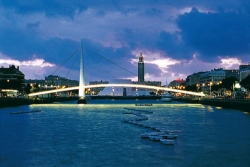
The Bassin du Commerce (Le Havre). © Ville du Havre
In 1852, the pressure of an overcrowded city centre drove Napoleon III to tear down the defensive walls, replace them with wide boulevards and annexe the surrounding towns. Le Havre became a major industrial city with a flourishing port for the trade of raw materials (cotton, coffee, spices, exotic wood) and passenger transportation with the advent of transatlantic liners.
Le Havre was one of the European cities the hardest hit by bombing at the end of World War II: the 150 hectares of the historic centre were destroyed.
In addition to its major role in export, the maritime and port city had strong ties to transatlantic traffic: its reconstruction was made a national priority to show the world that France was rising from the ashes. The immediate post-war French government decided to use all of the skills necessary to make Le Havre an exemplary city.
Exponents and former students of architect Auguste Perret united to create a post-war reconstruction studio for Le Havre. They applied the principles of structural classicism, combining the use of reinforced concrete and classical vocabulary.
Thus, between 1945 and 1964, approximately 100 architects produced an exceptionally homogeneous landscape in which the buildings reflect the many variations of the same architectural language.
In 2001, Le Havre joined the national network of Villes et Pays d'Art et d'Histoire (Cities and Regions of Art and History), thus laying down a set of outreach initiatives covering architectural, historical, societal and human heritage.
Natural History Museum
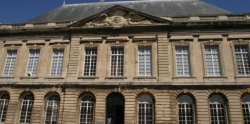
Natural History Museum. © Ville du Havre / Philippe Bréard
Its aim is to foster a desire to learn by teaming science and smiles, that is to say by keeping science simple to improve understanding and educate on the issues involved, to be a place for strengthening ties and sharing experiences between generations.
With a vast programme of temporary exhibitions, as well as guided tours, workshops, storytelling, performances, conferences and events, the museum prides itself as a place where the whole family can share in the discovery.
For the schedule of events and activities, see the Museum of Natural History website
Abbaye de Graville
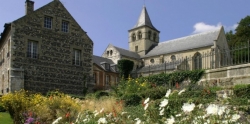
Graville abbey. © Ville du Havre / Philippe Bréard
The impressive Romantic cemetery encircling the abbey contains several graves of scholars and merchants from Le Havre, as well as children's grave markers bearing verses written by Victor Hugo. The terraced gardens to the south hug the slope. A monumental statue of the Madonna and Child looks out over the city. Called the "black virgin" because it replaced another statue of the Virgin Mary cast in a less noble alloy that corroded and turned black, the statue was erected by mothers of French soldiers in gratitude for saving the city during the Prussian invasion of 1870.
In the early 20th century, the abbey housed the stone and archaeological collections of the city's museum. Restored following the bombings of 1944, part of the abbey re-opened to the public in 1952. The entire complex is now a listed Historical Monument.
For more information on the Abbaye de Graville, see the City of Le Havre website
Maison de l'Armateur
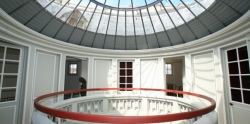
Maison de l'Armateur. © Ville du Havre / Philippe Bréard
Paul-Michel Thibault (1735–1799), architect of Le Havre's fortifications and hydraulic engineer for the city, decided around 1790 to build his own house following a highly original design in a densely populated yet affluent district of the city. The house was to reflect the owner's prestige and draw admiration from passers-by.
After World War II, the City of Le Havre and France's Department of Historic Monuments decided to safeguard the house, which had been severely damaged by the bombings, and open a museum of decorative arts, graphic arts and history of Le Havre from 1780 to 1830. An initial campaign to save the house was undertaken between 1946 and 1959. After a 15-year hiatus to focus on rebuilding the damaged city, the restoration and rehabilitation works began in 1979. After subsequent periods of standstill, the project finally gained momentum in 2005. The opening took place in 2006.
For more information on the Maison de l'Armateur, see the City of Le Havre website
Hôtel Dubocage de Bléville
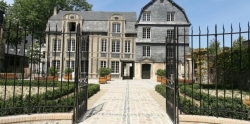
Hôtel Dubocage de Bléville. © Ville du Havre / Philippe Bréard
Home to a museum, this remarkable building, part of which is a listed Historical Monument, is easy to reach at the heart of Le Havre. Visitors are free to explore the new French gardens, as well as the exhibition rooms on the ground floor and the study rooms, to appropriate the space and forge a simple and natural relationship with this new museum.
The decorative objects, prints and paintings on display refer to the history of Le Havre and its harbour, in recognition of its vibrant maritime activity. In keeping with the history of the building, the artworks are displayed in a new exhibition design that treats the galleries as cabinets of curiosity. Guided tours are on Sundays at 3:30 p.m. The storerooms can be viewed the last Saturday of the month at 2 p.m. The Hôtel Dubocage de Bléville can arrange group tours outside of these hours upon reservation.
For more information on the Hôtel Dubocage de Bléville, see the City of Le Havre website
Espace André Graillot
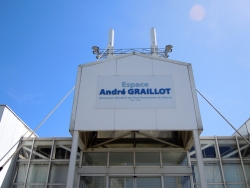
André Graillot. © Ville du Havre
Three exhibitions are held each year to recognize and promote the city's rich heritage. Collections from Le Havre include artworks, archival documents, photographs, films, merchant marine equipment and boats, including the beacon ship. The venue is of course open to external collections as well.
The space is run by volunteers from maritime associations.
For more information on the Espace André Graillot, see the City of Le Havre website
City of Art and History
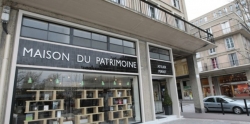
City of Art and History. © Ville du Havre / Erik Levilly
The flat is used to showcase the Atelier's proposed developments for rehousing the city's residents with features such as double exposure, optimal light, fitted kitchen and bathroom, garbage disposal and central forced-air heating. The furnishings chosen portray the typical apartments presented during the reconstruction (between 1945 and 1955) for the war-torn population of Le Havre. The living room has furniture by René Gabriel, the master bedroom has a suite by André Beaudoin and the children's bedroom has furniture by Marcel Gascoin.
This mass-produced furniture, the debut of French post-war design, is worth rediscovering for its rational aesthetic and quality workmanship. The origin of the "Glorious Thirty", three decades of economic prosperity in post-war France, is told here through everyday appliances such as the refrigerator, stove, pressure cooker, vacuum cleaner and washing machine, as well as record player, typewriter, clothing, newspapers and magazines that immerse visitors in an era that nourished the lifestyle we know today.
For more information on the City of Art and History, see the City of Le Havre website
Archives

Municipal archives. © Ville du Havre
The archives are held in storerooms with over 4 km of shelving.
Archives may be consulted by anyone upon request, in the reading room and in keeping with legal requirements.
Who comes to the Archives and why?
people working in municipal or inter-municipal departments for the operation of public services;
citizens or their authorized representatives (notaries, professional genealogists) to exercise their rights;
local and family history buffs, including amateur genealogists, and university researchers, primarily in the humanities;
For more information, see the municipal archives website
Lire au Havre
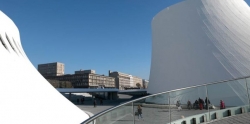
Space Oscar Niemeyer. © Erik Levilly
For more information, see the Lire au Havre website
Learn more

